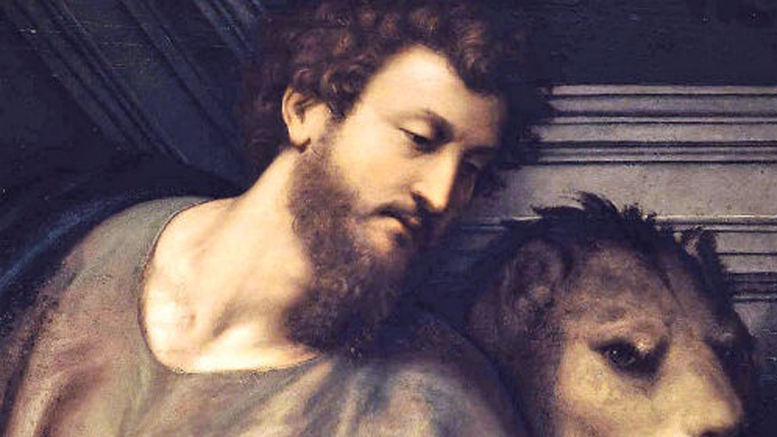Last Updated on October 23, 2019 by Editor
The fourth, and final, evangelist in our quarterly series is St. Mark, the writer of the oldest and shortest of the Gospels.
He is referred to as John Mark in Acts 12:12. According to Catholic tradition, Mark was the son of Mary of Jerusalem (Acts 12:12) whose home became a meeting place for the apostles. He also is the cousin of St. Barnabas (Colossians 4:10).

In art, St. Mark is depicted holding a palm and with an open book of his gospel; often, a lion is nearby. The lion was believed to sleep with its eyes open, a reference to Jesus defying eternal sleep in his tomb. In Venice, and elsewhere, the lion has wings, another heavenly reference.
Some scholars believe Mark was talking about himself when he tells about a young man who followed Jesus to Gethsemane, wearing nothing but a linen cloth. When the Romans tried to seize him, he wriggled out of his linen and ran away naked (Mark 14:51-52). This second piece of evidence would place Mark within the sphere of Jesus but not as one of the 12 original apostles. He probably was one of the 70 apostles who later were charged with spreading the faith.
Mark was close to St. Peter, who called him “his son” (1 Peter 5:13). He traveled with Peter as his interpreter and wrote down his sermons, which eventually would develop into his gospels. Those writings were addressed to the gentiles of Rome after Peter’s death, helping the unbelievers to understand how a Messiah could be cruelly murdered by his own people.
Mark also had a connection to St. Paul. In fact, he accompanied him and St. Barnabas on their first missionary journey to Antioch in 44 A.D. At some point, Mark left his companions to return to Jerusalem because he got homesick (Acts 13:13). That gave Paul doubts about Mark’s commitment as a carrier of the “Good News” and he refused to invite Mark on his second mission to Cilicia and the rest of Asia Minor. Paul’s anger did not last. When he was imprisoned in Rome, Mark came to visit him as one of his trusted companions (Col. 4:10).
We know Mark finally got his chance to preach in Asia Minor because Paul wrote to Timothy at Ephesus advising him to “take Mark and bring him with you (to Rome) for he is profitable to me for the ministry” (2 Timothy 4:11). If Mark did accompany Timothy to Rome at that time he would have been there when Paul was martyred.
Though shorter than the other gospels, Mark’s writing and his experiences were a source to Luke and Matthew. Tradition says that around 49 A.D. Mark went to Alexandria, Egypt, and established the Church of Alexandria. The Coptic Orthodox, Greek Orthodox and Catholic Churches of Alexandria are descended from that original congregation. Mark became the first bishop of Alexandria and is known as the founder of Christianity in Africa.
In 68 A.D. Mark was martyred by a mob in Alexandria who objected to his teachings. A noose was placed around his neck and he was dragged through the streets by a horse until he died. His remains were buried in Alexandria but later divided. In 828, relics of St. Mark were stolen from Alexandria, covered with cabbage leaves and pork to avoid inspection by the Muslim guards of the Abbasid Caliphate, and taken to Venice, Italy. The Coptic Church maintains that his head still is in Alexandria. And Cairo claims to have another portion of his remains.
Sources: www.catholic.org, www.franciscanmedia.org, https://marktheevangelist.weebly.com/biography-of-st-mark.html.
